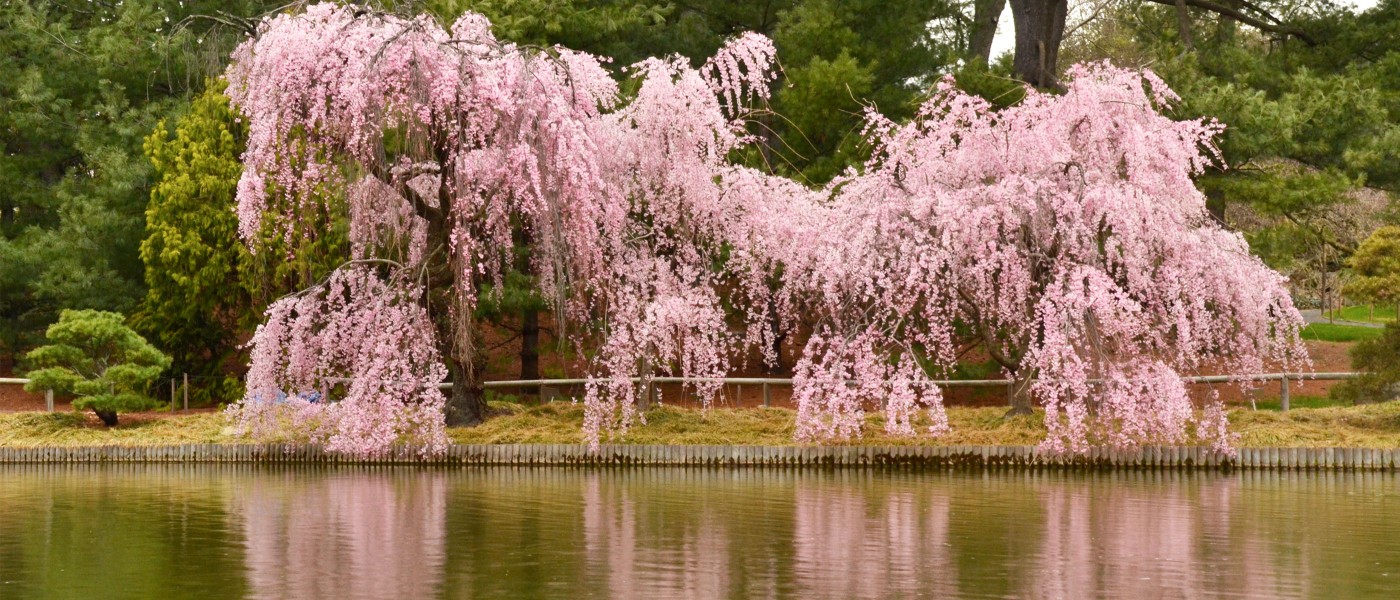Flowering Cherry Collection FAQ
When Do They Bloom?
Flowering cherries bloom at the Garden from late March or early April through mid May.
Each tree remains in flower for just a week or so, and there is no moment when all are blooming at once. Instead, different species and cultivars blossom in succession, allowing many opportunities to savor the season.
The very first cherry trees to blossom usually do so at the same time that the daffodils bloom. So when you see daffodils throughout the Garden, look for Prunus × incam ‘Okame’ in the Cherry Cultivars Area and Prunus hirtipes in the Plant Family Collection. The rest of the cherry blossoms will appear in the four or so weeks following this first bloom.
More: Learn more about the art of predicting cherry blossoms.
Temperature, precipitation, and other variations in weather all contribute to the timing of the blooms. These same factors determine how long they will linger.
Where Are They Located?
Japanese Hill-and-Pond Garden*
Flowering cherry varieties are located throughout this enclosed garden. Early in the cherry blossom season, the delicate weeping higan cherries (Prunus pendula ‘Pendula Rosea’) that border the pond offer a tranquil panorama. These are some of the oldest trees in the collection and display great character with their knobby branches and thick trunks.
More: Take a virtual stroll through the Japanese Hill-and-Pond Garden during cherry blossom season.
Here you’ll also find a winter-blooming cultivar, P. ‘Fudan-zakura’, which flowers intermittently during mild winters. One of the collection’s sweetest-smelling trees, P. ‘Shirotae’, is located near the viewing pavilion. A late-flowering cultivar near the waterfall, P. ‘Ukon’, has unusual pale-green blossoms.
Cherry Cultivars Area*
A dozen different varieties of flowering cherries are planted just west of the Japanese Hill-and-Pond-Garden near Cherry Walk. This display provides a wonderful opportunity to observe different forms of blossoms and bloom times. Here you will find Prunus × incam ‘Okame’, usually the first cherry to flower at BBG. Its bloom signals the start of hanami—the cherry-blossom viewing season.
Another highlight is the white Yoshino cherry, Prunus × yedoensis, the favorite in Japan, where delicate, simple forms are highly valued. Yoshino cherries are seen all over Tokyo. One of the last trees to bloom, P. ‘Kurayama’ is also found here. It features showy, pale-pink clusters of double blossoms.
Cherry Walk*
This meandering path located to the east of Cherry Esplanade is lined with extravagant, pink-flowering Prunus ‘Kanzan’ trees that form a delightful bower near the end of cherry blossom season. While most cherry blossoms have 5 petals, ‘Kanzan’ is a double flowering cultivar with up to 28 petals on each bloom. Cherry Walk was created in 1921 with trees purchased from a Long Island nursery. The two higan trees at the north end of Cherry Walk date back to this original planting and are the oldest in the collection.
Cherry Esplanade*
The dazzling finale to the cherry blossom season takes place on this open lawn lined with two allées of Prunus ‘Kanzan’. You may notice some younger trees among the 76 specimens here. Cherry trees typically live 25 to 30 years, and those that succumb are replaced immediately.
More: Take a virtual walk around Cherry Esplanade during cherry blossom season.
Osborne Garden
A magnificent pair of Prunus ‘Shogetsu’ frames the north end of Osborne Garden, greeting visitors who enter by the Eastern Parkway entrance. Other cultivars found on the north end of Osborne Garden include P. ‘Shirotae’, P. ‘Hatazakura’, P. ‘Kanzan’, and P. ‘Takasago’.
Plant Family Collection
Several varieties of flowering cherries and related species (see below) are found on the Plant Family Collection’s Prunus lawn, in the central area of the Garden west of the Palm House.
Other Locations
BBG’s Bonsai Collection includes about a dozen cherry trees, which are displayed when they are in bloom. You’ll also find cherries planted on the Overlook slope, along Washington Avenue, at the Washington Avenue entrance (across from the Garden Shop) and near the Fragrance Garden.
Flowering Trees That Are Not Cherries
Prunus is a large genus that contains many well-known stone fruits besides cherries: peaches, apricots, almonds, and plums. Some Prunus species have inconspicuous flowers or more shrub-like forms. Others are bred for ornamental value. At BBG during cherry blossom season, look for the showy flowers of Prunus armeniaca (apricot) and P. glandulosa (almond) in the Shakespeare Garden, P. davidiana (peach) west of the Annual Border, and P. mume (apricot) specimens in the Bonsai Collection.
Many other trees flower in the spring, too, so look for the plant label if you want to know exactly what you are seeing. Magnolia Plaza is usually in bloom along with the earliest cherries. Pears (Pyrus species) and apples, including crabapples, (Malus species) bloom later, with flowers that look very similar to cherry blossoms.


